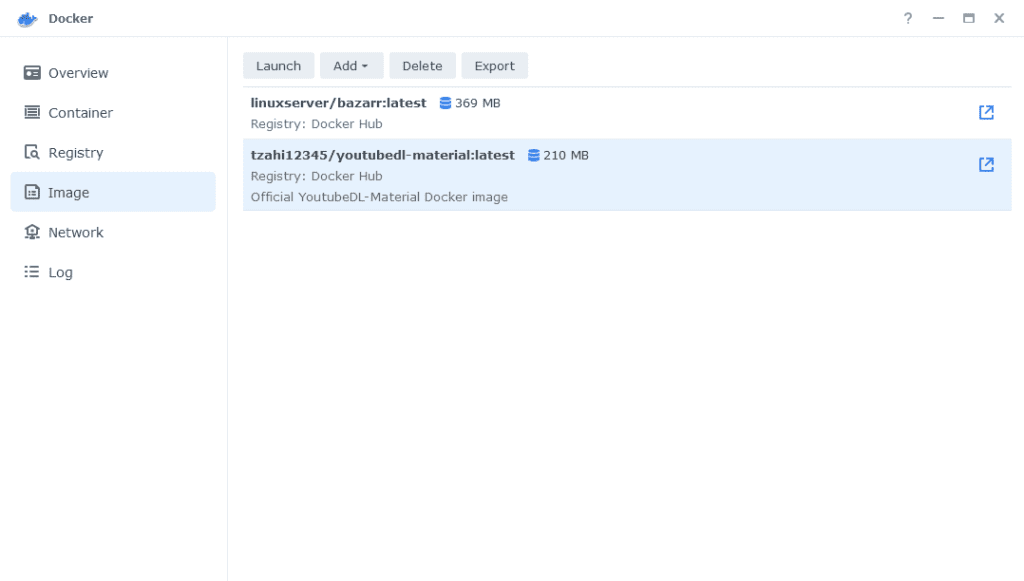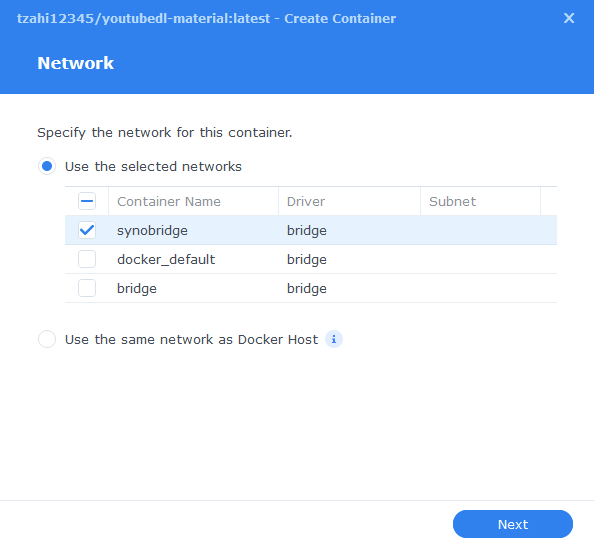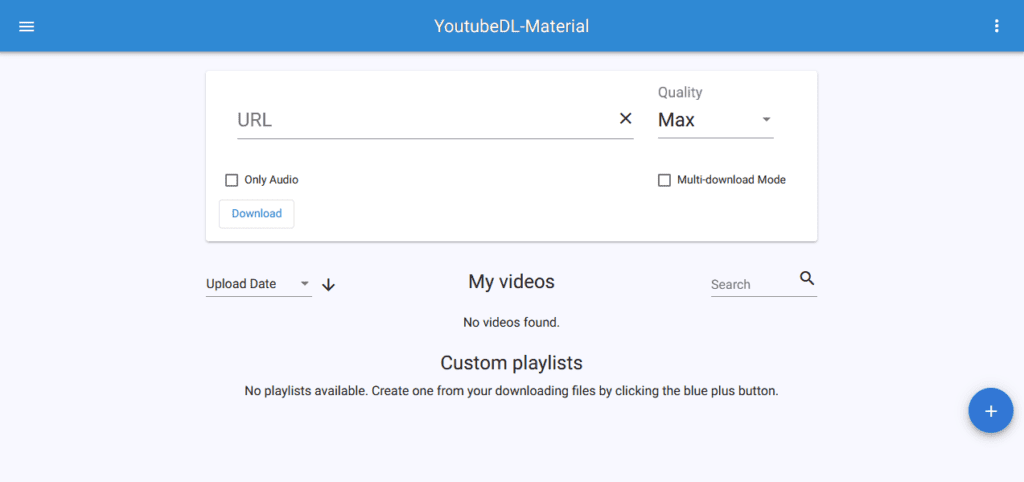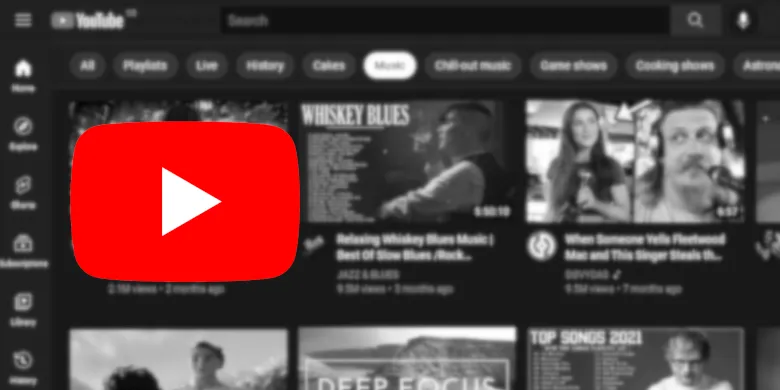Last updated on 6 April 2025
Please note if you are using DSM7.2 or higher you should use the Container Manager version of this guide from the menu.
This guide has reached the end of its updates as most people are now on the latest DSM update - This guide is correct as of 08/12/2023 however no further updates will be added.
| Update | Date |
|---|---|
| Removed docker compose section as rarely used | 18/07/2023 |
| changed image to nightly as this receives the most recent bug fixes and improvements | 04/12/2023 |
What is YouTubeDL Material?
YouTubeDL Material is nice web front end for YoutubeDL, This is a tool that is used to download video from YouTube and many other sites. This is useful for if you want copies of videos to watch locally offline or if you like to hoard entire channels!
Let’s Begin
In this guide I am going to take you through the steps to get YoutubeDL Material up and running in Docker on your Synology NAS
In order for you to successfully use this guide please complete the two steps below first.
Downloading the Container
Open up Docker within DSM and navigate to the ‘Registry’ tab and search for ‘tzahi12345’ in the keyword box.

Within the results right click and download the top result ‘, When it asks which version number to download select ‘nightly‘ as this has the most recent updates for this container.

Setting up the container
Now we have downloaded the image and got hold of our user IDs we can move onto the next stage.
Go back into Docker and click on the ‘Image’ tab, in the list of your containers select the image, and click on ‘Launch’

The first screen will ask how you want to set up the Docker network, we are going to use the ‘bridge’ network allowing us to amend ports later.

General Settings
Next you will be greeted with the General Settings screen, this is where you can start specifying some of your preferences.
You can change the name of the container to anything you like, and you may want to enable Auto Restart as this will ensure the container starts automatically if you reboot your NAS.
You will also notice a Configure capabilities button — don’t change anything in here!

Next up we are going to click on the ‘Advanced Settings’ button, this will take you to a new window with a number of tabs which we are going to work through.
Environment
Next we are going to set up a couple of environment variables that docker will use to allow the container access to our files and folders.
Click the Add button, and fill in the following details as per the table/screenshot, you will need to do one at a time.
| Variable | Value |
|---|---|
| UID | The UID you obtained in the user setup guide |
| GID | The GID you obtained in the user setup guide |
| USER | youtube |
| ytdl_use_local_db | true |
| write_ytdl_config | true |
| ytdl_port | 9998 |

Links/Execution Commands
You do not need to set up anything on these tabs.
Press ‘Save’ to go back to the initial setup screen, then press ‘Next’
Port Settings
On this screen we are going to specify port 9998 to access YouTubeDL, this is in line with the Environment Variable set earlier. You will need to change BOTH the Local Port and the Container Port (we don’t normally do this)

Volume Settings
Where you store your downloaded videos can be changed based on your own preferences, I am basing this guide on the overall media setup and folder structure from our other guides.
Create a ‘youtube’ folder in /data/media and then add 4 subfolders
- audio
- subscriptions
- users
- video

We can now move onto the volume tab in which we will be specifying the directories where YoutubeDL will store its configuration files and where the video downloads will be stored.
Click on Add Folder, click on the ‘docker’ share and create a new sub-folder called ‘youtubedl’ click on this folder and click ‘select’

We now need to repeat this process adding the folders below one at a time. Your path settings should look like the table/screenshot below.
| File/Folder | Mount path |
|---|---|
| /docker/youtubedl | /app/appdata |
| /data/media/youtube/subscriptions | /app/subscriptions |
| /data/media/youtube/users | /app/users |
| /data/media/youtube/audio | /app/audio |
| /data/media/youtube/video | /app/video |

Click Next to move to the final screen.
Summary
You have now completed the setup of the container.
You will be shown an overall summary of the settings we have specified, this is a good time to double-check everything is correct. Finally, click on Done and the container should start to boot.

You should now be able to access the web interface via the IP of your NAS followed by the port 9998
e.g. 192.168.0.40:9998

You can use the main screen to download individual videos by pasting the URL and selecting the quality, or if you want to add subscriptions to specific channels use the menu on the left.
I recommend going into the advanced settings and amending the downloader to ‘yt-dlp’ if you have any issues pulling videos.
| Historic Updates | Date |
|---|---|
| New guide published | 05/03/2022 |
| Small amendment made to the environment variables to specify the use of a local database | 10/05/2022 |
| Updated with DSM7.1 Steps and Screenshots | 23/06/2022 |
| Changes to ‘latest’ image and update steps | 09/07/2022 |
| Added new port settings and Docker Bridge Network | 23/07/2022 |
| Fixed a rogue old image for the ports section use ports 9998 on both sides! | 08/09/2022 |
| Removed the default downloader so you can select one from the settings after startup. | 26/01/2023 |
| Compose version number removed and small wording amendments | 09/04/2023 |
| Amended the path to save the compose file – this is for security, so the container has no access to the file contents. | 14/04/2023 |
Looking for some help, join our Discord community
If you are struggling with any steps in the guides or looking to branch out into other containers join our Discord community!
Buy me a beverage!
If you have found my site useful please consider pinging me a tip as it helps cover the cost of running things or just lets me stay hydrated. Plus 10% goes to the devs of the apps I do guides for every year.




The tool is still working? It always says download failed! when I try to dowload something
Hey, yes the tool should be working just fine, double-check your settings for the UID and GID to ensure the container can write to the filesystem. Also, if not already in the settings > advanced make sure you are using yt-dlp.
Omg, I was in auto pilot when I created it and instead of change UID and GID I created new fields PUID and PGID… thank you for your reply and for the guides.
So, I have it all set up as specced (with my own variables, of course), and it seems to be running:
I’ve checked, and port 9998 is listening, however when attempting to connect, I get a “site cannot be reached” error in the browser. Synology firewall isn’t active, so that’s not an issue (as demonstrated here):
C:\Program Files (x86)\Nmap>ncat -zv 192.168.1.200 9998
Ncat: Version 7.92 ( https://nmap.org/ncat )
Ncat: Connected to 192.168.1.200:9998.
Ncat: 0 bytes sent, 0 bytes received in 0.01 seconds.
I switched to the default network bridge my Sonarr and NZBGet containers are using, as well as tried it with the root user, with the same result.
Any thoughts? Thanks!
Hey, would you be able to post your containers logs to https://paste.drfrankenstein.co.uk (paste the link here) – I suspect something is not being created correctly.
Hey – So Amit reached out, and we spotted that I have a rogue image in this guide! Use Port 9998 on both the Local AND Container ports.
Hi Dr. Frank,
I installed youtubedl and it works great. However, I am using it to record a live radio station. Not 100% functional to my needs. I cant for example stop the recording unless I delete the part of the mp3 from the audio folder nor I can schedule a recording. I tried clue/streamripper docker but it does not process https links correctly since my radio station streams in mp3 with https. Do you know any docker container that can perform such thing? Thank you in advance for all your hard work and your time.
Hey that’s a pretty niche thing you ate looking for, not something I have come across but it may be worth asking over on the self-hosted Discord or sub reddit.
https://discord.gg/yDxNAarW
https://reddit.com/r/selfhosted
Lots of other self hosters like us
Thanks
Thank you again!
Is this project dead?
I don’t think it’s dead – had some translations pulled into it last month. It still works fine.
2022-04-02T18:51:48.864Z INFO: Cannot find config file. Creating one with default values…
2022-04-02T18:51:48.897Z INFO: Beginning migration: 4.1->4.2+
2022-04-02T18:51:48.906Z ERROR: EACCES: permission denied, scandir ‘audio/’
2022-04-02T18:51:48.906Z ERROR: Migration failed: 4.1->4.2+
2022-04-02T18:51:48.907Z INFO: Beginning migration: 4.2->4.3+
2022-04-02T18:51:48.918Z INFO: 4.2->4.3+ migration complete!
2022-04-02T18:51:49.293Z INFO: Found new update for youtube-dl. Updating binary…
2022-04-02T18:51:50.763Z INFO: YoutubeDL-Material v4.2 started on PORT 17442
2022-04-02T19:00:26.259Z ERROR: ERROR: Cannot write metadata to JSON file video/CNCF Kubernetes and Cloud Native Associate Certification Course (KCNA) – Pass the Exam!.info.json
I setup the mounts as per your guide
Hey, it looks like it is failing to get permission to write to your folders, double check you set the UID and GID correctly as it can be easy to put them the wrong way around.
Yes they are set correctly. These are the detail I got and I set the uid and gid details the same.
uid=1026(gblades) gid=100(users) groups=100(users),101(administrators)
I have a calibre server running as the same user without issues. The only difference is the YouTube docker image is set to access a volume outside of /docker but I can’t imagine that would be an issue
Sorry I completely missed your reply, make sure the user has write permissions. If that fails try deleting the YouTubedl image and re downloading it just in case there is an issue with it.
I’m using NASInternal/Media/youtube/audio as one of the paths as an example. No spaces in any names. I don’t think capitals would be an issue but I remember reading something about it. Probably just to avoid issues with case sensitivity in Linux compared to windows.
I’ll have a play and setup new file paths to see if I can get it working on Monday. Thanks
To solve your problem, don’t use any path outside docker directory.
I know this is now months later but – Amit reached out, and we spotted that I have a rogue image in this guide! Use Port 9998 on both the Local AND Container ports!!.